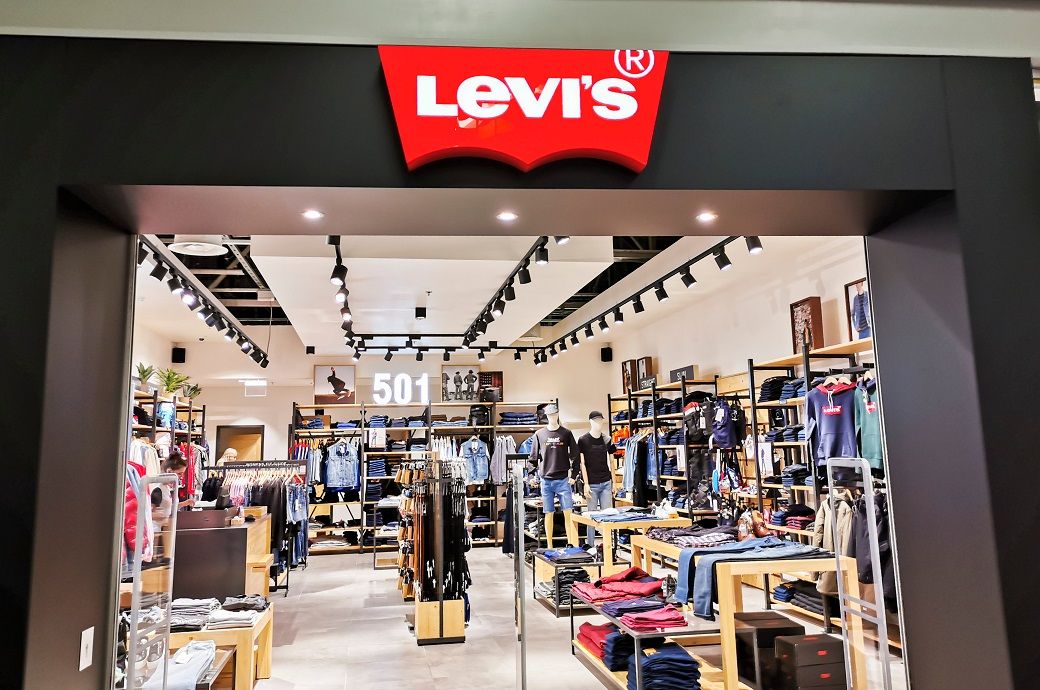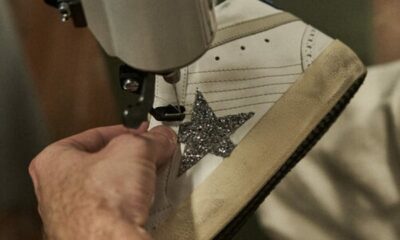Fashion
US apparel and footwear deals surge to record $21B as brands react to tariff pressure

By
Reuters
Published
September 18, 2025
U.S. President Donald Trump’s trade war is helping push U.S. clothing and footwear acquisitions to all-time highs this year, with some companies merging to help offset tariff costs while others go private to weather the next 3-1/2 years of his presidency outside the public market, dealmakers say.
Popular sneaker company Skechers announced a $9.42 billion deal in early May to go private, days after it withdrew its annual earnings forecasts and sent a letter — along with 75 other footwear companies — to Trump, stating that the tariffs were an “existential threat” to the industry.
Sneaker seller Foot Locker, which also signed the letter to Trump, in May accelerated its $2.4 billion sale to Dick’s Sporting Goods. While both deals were in the works for months, bankers and analysts said Trump’s tariffs are creating both chaos and opportunity for retailers and brands to explore tie-ups. This has driven dealmaking in the U.S. footwear and apparel sectors to roughly $21 billion in announced deals year-to-date.
With more than three months left in the year, that figure is already a record, according to LSEG data dating back to the 1970s — particularly surprising for an industry where valuations are not nearly as lofty as those in tech or financial services. The previous record for U.S. apparel and footwear M&A was last year’s $16.1 billion, and before that, 2021’s $15.6 billion, according to LSEG.
“Scale is more important in a tariff-rich environment because you can negotiate better terms across a larger base with many of your counterparties,” said Carmen Molinos, Morgan Stanley’s global co-head of consumer retail investment banking.
Morgan Stanley advised Canadian apparel maker Gildan Activewear on its acquisition last month of U.S. underwear maker Hanesbrands for $2.2 billion.
Both companies produce more in Central America and the Caribbean than in Asia, and primarily use U.S.-grown cotton, which provides them with some protection from tariffs. The combination insulates them more from fluctuating geopolitics, and Gildan was one company looking to get bigger amid the chaos.
“We think that we’re really well aligned to take advantage, actually, of this near-shoring opportunity,” Gildan’s CEO and co-founder Glenn Chamandy said on an August investor call about the deal.
Tariffs were a shock to the system that showed retailers just how quickly their businesses could get disrupted, highlighting the importance of scale, several bankers said.
“In moments of turmoil and change, those who are in a position of strength are looking to build up on those strengths, and if they see the right strategic fit, they’re taking advantage (and buying),” said JPMorgan’s Jonathan Dunlop, co-head of North America consumer and retail investment banking.
This year, JPMorgan advised 3G Capital on Skechers and brand management firm Authentic Brands Group’s $1.4 billion deal last month for Guess. Authentic also picked up Dockers from Levi Strauss, while another brand management firm, Bluestar Alliance, announced a deal to buy Dickies from VF Corp this week.
Brand management firms typically buy a brand’s IP and then license it to operating partners that handle manufacturing, design, and sales.
“The brand management companies have been some of the most prolific acquirers of both middle-market and a handful of multi-billion-dollar retail brands,” said David Shiffman, partner and head of consumer retail at Solomon Partners. The bank advised the special committee of Guess.
Navigating the uncertainty
Going private, as in Skechers’ case, is becoming an increasingly attractive option to navigate the uncertainty without the pressure of public quarterly reporting — especially if companies feel the public market is not valuing them appropriately.
Foot Locker, meanwhile, had been in discussions about a sale since Dick’s Executive Chairman Edward Stack first reached out to rival CEO Mary Dillon in January 2024.
Trump’s April 2 self-styled “Liberation Day,” when he announced sweeping new global tariffs, helped seal the deal earlier than expected, according to an SEC filing. Foot Locker said tariffs were causing the company’s stock to drop and that it was headed for a weaker-than-expected first-quarter earnings report — a development executives feared would further depress shares.
The board decided on May 10 to try to bring “negotiations to a close quickly,” it said in a securities filing. The next four days were a flurry of paperwork and legal meetings before the companies announced their deal — with two weeks to spare before reporting earnings.
Bankers advise watching for more tie-ups later this year as stronger retailers seek deals and struggling companies look for partners.
Private equity firm Bain Capital is trying to offload its stake in Canada Goose, and Lands’ End has received offers from brand management firms.
© Thomson Reuters 2025 All rights reserved.
Fashion
S/S 2027 trends emerge as Intertextile Apparel unveils Paradox

In today’s context, a paradox is about casting an optimistic gaze upon the world, rekindling the consumer’s desire, and nurturing a sense of well-being – where daring to step into the light is the theme of the season, set to generate a fresh new dynamic. PARADOX is the thread connecting the S/S 2027 fashion trends – AFFECTION, BREATHE, BEWITCHING, and HONOURATION – conceived by four leading forecasters from the world’s fashion capitals. From 11 – 13 March 2026 at Intertextile Shanghai Apparel Fabrics – Spring Edition, visitors will be able to explore these trends in depth at the Trend Forum in Hall 5.1 of the National Exhibition and Convention Center (Shanghai).
Intertextile Shanghai Apparel Fabrics – Spring Edition (March 11–13, 2026) will spotlight S/S 2027 trends under the theme Paradox at the Trend Forum in Hall 5.1.
Conceived by global forecasters, four themes—Affection, Breathe, Bewitching and Honouration—explore optimism, authenticity, craftsmanship and well-being through over 700 fabric and accessory samples.
At the upcoming Spring Edition, Sachiko Inoue (Tokyo) is tasked with bringing the concept to life at the Intertextile Directions Trend Forum, after conceiving the trends together with Directions Trend Committee members NellyRodi Agency (Paris), DONEGER | TOBE (New York), and Elementi Moda (Milan). The Trend Forum will showcase over 700 fabrics and accessories samples, with the Trend Guide serving as a handbook for buyers to source on-trend fabrics, patterns, prints, and colours.
Accept imperfection: fostering self-confidence through authenticity and simplicity
Less about status and more about contemplation, fashion fosters self-confidence through authenticity, simplicity, and even embracing imperfections. Across four central themes, the PARADOX movement champions individuality over spectacle, valuing durability and a serene, discreet elegance.
AFFECTION
Citywear transforms into easywear, designed for comfort and to encourage stepping outside. The theme blends masculine and feminine elements while mixing traditional craftsmanship with sporty codes: hybrid garments bring functionality, elegance, and effortless style.
Colours include a palette of subtle neutrals, centred on whites and off-whites, painted with soft greys, and tinted with greenery and new-dawn yellow. Including prints and patterns alluding to everyday poetry, fabrics combine tech and precious wool with delicate checks and subtle stripes.
BREATHE
Nautical codes combine urban elegance with smart functionality, adapted to shifting weather conditions. The iconic stripes of the beaches’ buoys and deckchairs infuse a reassuring, joyful, and sunlit dimension into a casual wardrobe, while aquatic inspiration appears in soft, refined layering.
A refreshing colour range is enriched with invigorating aqua and oxygenated blues; fabrics utilise innovative tech with a soft touch; while prints and patterns include elements like subtle burnout jacquard, satin finishes, and wave-like dévoré denim, all combining to reflect a casual, audacious and elegant style.
BEWITCHING
Whether altruistic or enchanting, with this theme women exude everyday sensuality, effortless sophistication, and a celebration of ancestral craftsmanship. Fluid drapes and organic prints draw inspiration from nocturnal forests and dark rituals, while a tarot and lucky charm spirit shapes the radiance of an urban adventurer brimming with emotion.
Vivid, unusual colours burst against dark, mysterious backgrounds, representing a palette of symbolic darks and bright hues. Patterns are inspired by artisanal heritage and natural elements, ranging from elegant to sensual and daring. Fabrics, meanwhile, evoke nature’s nocturnal mystery through abstract chiffons, organza and silks; tone-on-tone washed texture tie-dye; and striped monochrome and shiny satin.
HONOURATION
Demonstrating the ancestral know-how and excellence of craftsmanship, this theme reflects artisanal traditions from around the world, where modest natural materials are elevated to reveal simple refinement, discreet value, and elegant pieces without ostentation.
The colour palette plays on the contrasts between warm neutral tones inspired by raw, refined or precious materials, combined with intense, highly pigmented brights. Fabrics and patterns include innovative ikats, geometric abstract, basketweaves, blurred stripes, and discreet neoclassical flora.
The fair is co-organised by Messe Frankfurt (HK) Ltd; the Sub-Council of Textile Industry, CCPIT; and the China Textile Information Centre. It will take place alongside Yarn Expo Spring, Intertextile Shanghai Home Textiles – Spring Edition, CHIC and PH Value at the National Exhibition and Convention Center (Shanghai).
Intertextile Shanghai Apparel Fabrics – Spring Edition will be held from 11 – 13 March 2026.
Other upcoming shows:
Vietnam International Trade Fair for Apparel, Textiles and Textile Technologies
26 – 28 February 2026, Ho Chi Minh City
Intertextile Shenzhen Apparel Fabrics / Yarn Expo Shenzhen
9 – 11 June 2026, Shenzhen (Futian)
Intertextile Shanghai Apparel Fabrics – Autumn Edition / Yarn Expo Autumn
25 – 27 August 2026, Shanghai
Note: The headline, insights, and image of this press release may have been refined by the Fibre2Fashion staff; the rest of the content remains unchanged.
Fibre2Fashion News Desk (HU)
Fashion
US brand Levi Strauss appoints H&R Block CEO Jeffrey Jones to board

“Mr. Jones brings extensive experience in consumer insights, brand building and organizational transformation and has a proven record of creating significant stakeholder value,” said Bob Eckert, chair of the board of Levi Strauss & Co. “He has repeatedly strengthened brands and organizations across industries, and his leadership will play a critical role as we evolve LS&Co. into a best-in-class, DTC-first retailer.”
Levi Strauss & Co has appointed H&R Block president and CEO Jeffrey J Jones II to its board, effective January 21, 2026.
He will serve on the nominating, governance and corporate citizenship committee and the compensation and human capital committee.
Jones brings over 30 years of experience in consumer, retail and technology leadership, strengthening LS&Co’s DTC-focused strategy.
Mr. Jones has served as President, Chief Executive Officer and Director of H&R Block, Inc. since 2017 and will retire from the company on December 31, 2025. He previously served as President of Ride Sharing at Uber Technologies Inc., where he led operations, customer support, strategy and planning, product operations and marketing. Mr. Jones also served as Executive Vice President and Chief Marketing Officer at Target Corporation, overseeing brand, digital and guest experience strategy, corporate communications, investor relations and brand management of all owned brands and Target’s limited-time offering collaborations. Earlier in his career, Mr. Jones was partner and President of McKinney, an advertising agency, where he led major client engagements and organizational growth.
“Levi Strauss & Co. is an iconic company with a bold vision for the future, and I’m honored to join the board at such a pivotal moment,” said Jeffrey J. Jones II. “The company has been on a strong trajectory, deepening its connection with consumers and driving long-term, sustainable growth. I look forward to supporting the entire leadership team as they write the next chapter for this nearly 175-year-old company.”
Mr. Jones is a member of the Council for Inclusive Capitalism, the Fast Company Impact Council and the Kansas City Economic Club. He holds a Bachelor of Arts degree in Communications from the University of Dayton.
Note: The headline, insights, and image of this press release may have been refined by the Fibre2Fashion staff; the rest of the content remains unchanged.
Fibre2Fashion News Desk (RM)
Fashion
Columbia launches star-studded US Curling team uniforms for 2026

USA athletes and coaches across the Men’s, Women’s, Mixed Doubles, and Wheelchair National Teams will compete in uniforms that tell a story of our country’s heritage and stunning landscapes. The dark jersey features eight cascading stars in red, white and blue – symbolizing the curling stones used in competition. And in a powerful tribute to history, every jersey is adorned with at least 250 stars, celebrating the upcoming 250th anniversary of America’s independence.
Columbia Sportswear returns as official uniform sponsor for the US Curling National Team at the 2026 Winter Olympic Games, blending technical performance with national pride.
New competition and village wear feature heritage-inspired designs, Omni-Heat Infinity insulation, and 250 stars marking America’s upcoming 250th independence anniversary, with replica jerseys available for fans.
In addition to the competition jerseys, pants and hats, Columbia is providing athletes with village wear, including USA-branded parkas. The parkas are insulated with Columbia’s award-winning Omni-Heat Infinity, the brand’s warmest technology, reimagined in a patriotic gold star pattern to honor the historic games.
“Outfitting the United States Curling Team for the Olympic stage is an incredible honor and our teams have worked closely with USA Curling over the past several years to help propel them to the podium in Italy,” said Joe Boyle, President of Columbia Sportswear. “The uniforms are a testament to our commitment to these ambassadors – and we’re proud to support these athletes as they compete at the highest level.”
“Preparing for the Winter Games demands more than just talent; it requires gear that performs under pressure,” said Dean Gemmell, CEO of USA Curling. “Columbia’s technical expertise and athlete-first approach make them trusted partners as we head to Italy with confidence.”
Note: The headline, insights, and image of this press release may have been refined by the Fibre2Fashion staff; the rest of the content remains unchanged.
Fibre2Fashion News Desk (RM)
-

 Business7 days ago
Business7 days agoHitting The ‘High Notes’ In Ties: Nepal Set To Lift Ban On Indian Bills Above ₹100
-

 Tech6 days ago
Tech6 days agoFor the First Time, AI Analyzes Language as Well as a Human Expert
-

 Business5 days ago
Business5 days agoKSE-100 index gains 876 points amid cut in policy rate | The Express Tribune
-

 Business5 days ago
Business5 days agoStudying Abroad Is Costly, But Not Impossible: Experts On Smarter Financial Planning
-

 Business1 week ago
Business1 week agoIPO Explained: Meaning, Process, Benefits, Risks
-

 Sports5 days ago
Sports5 days agoJets defensive lineman rips NFL officials after ejection vs Jaguars
-

 Tech1 week ago
Tech1 week agoCursor Launches an AI Coding Tool For Designers
-

 Politics1 week ago
Politics1 week agoBangladesh to hold national election on February 12
















